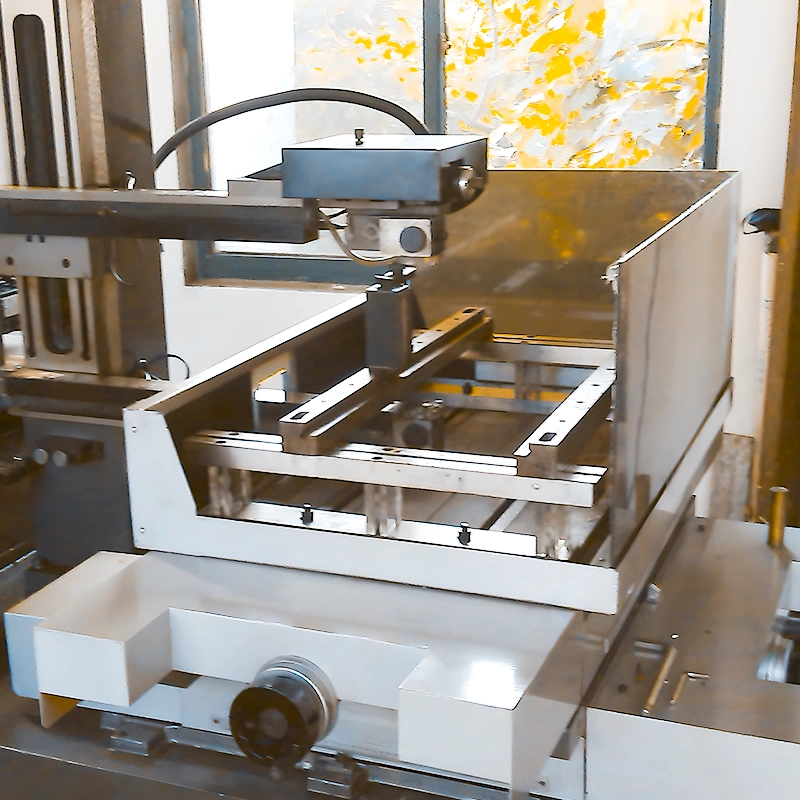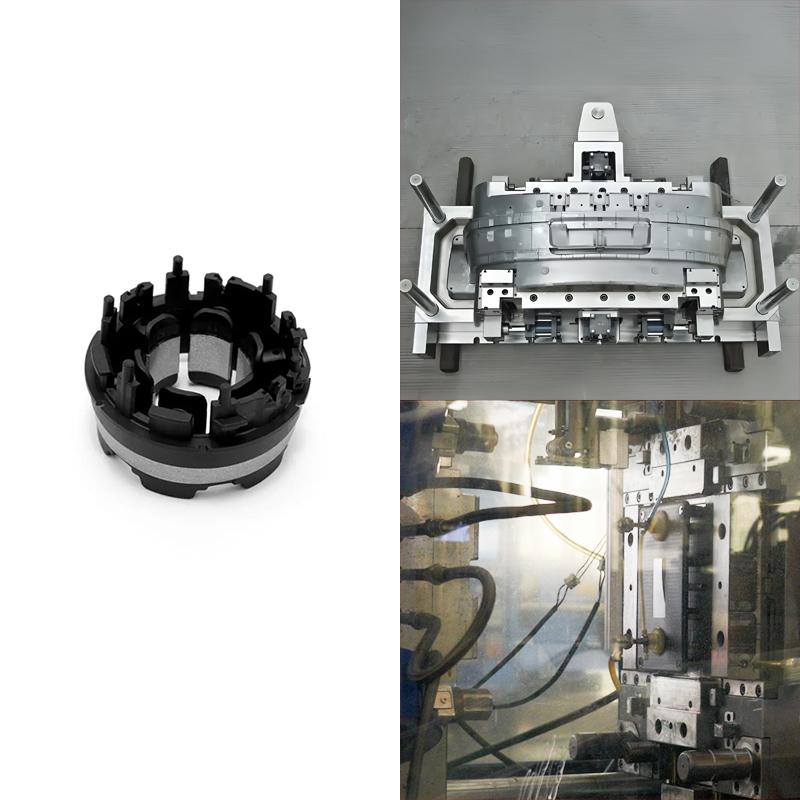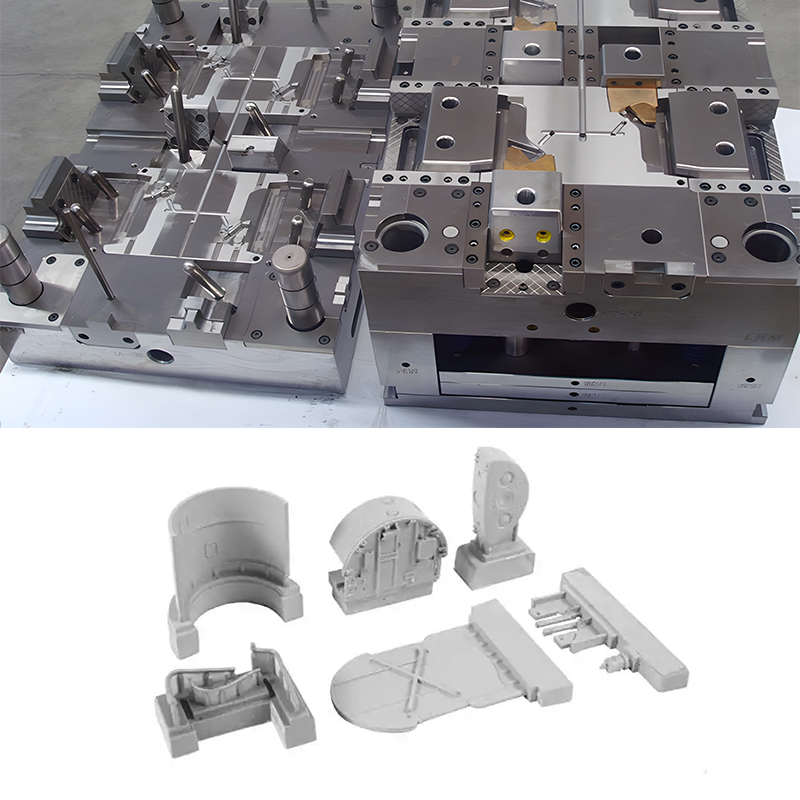EDM Wire cutting, also known as wire cutting or wire EDM, is a new process developed from traditional EDM. It is widely used in production and new product development to cut parts directly, improving production speed or shortening development cycles. This article introduces some aspects of EDM wire cutting to help you understand this technique better.
What is EDM Wire Cutting: How Does It Work?
The basic principle of wire cutting is to use a continuously moving thin metal wire (usually molybdenum or copper) as an electrode. This wire performs pulsed spark discharges on the workpiece, eroding the metal and forming the cut.
During cutting, pulsed discharges occur between the electrode wire and the workpiece. The wire connects to the negative terminal of a pulse power supply, and the workpiece connects to the positive terminal. When a pulse voltage is applied, a spark discharge occurs, with temperatures exceeding 10,000°C at the discharge channel center. This high temperature melts and even vaporizes the metal, causing localized expansion and micro-explosions that eject molten and vaporized metal, thus achieving electrical erosion cutting.
Classification of Wire Cutting
Wire cutting, or wire EDM, can be classified based on the speed of the electrode wire:
High-Speed Wire Cutting (Fast Wire EDM)
- Wire EDM machines with high-speed reciprocating wire movement (8-10 m/s).
Low-Speed Wire Cutting (Slow Wire EDM)
- Wire EDM machines with unidirectional low-speed wire movement (0.2 m/s).
Medium-Speed Wire EDM
- These machines enable multiple cuts on a fast reciprocating wire EDM machine, also known in some circles as “medium-speed wire EDM.” The term doesn’t denote intermediate speed but refers to a combination of high-speed wire for roughing and low-speed wire for finishing, resulting in quality between high-speed and low-speed machines.
Characteristics of Wire Cutting
Wire cutting, or EDM wire cutting, boasts several key features:
- High Precision: The fine wire allows for highly precise cuts, capable of ±0.01mm accuracy and surface roughness of Rα 1.25-2.5um.
- Flexible Shapes: Ideal for intricate and small-sized parts, particularly irregular shapes or sharp corners.
- Minimal Heat Effect: The heat generated is localized, suitable for heat-sensitive materials, maintaining dimensional stability.
- No Macroscopic Cutting Force: Non-contact processing avoids part deformation, making it suitable for low-stiffness workpieces with high surface finish.
- High Material Utilization: The narrow cut width means minimal material waste, though the cost is higher, making it less suitable for mass production.
- Automated Control: Wire EDM utilizes easily adjustable electric parameters and a CNC system for automated control.
Despite these advantages, wire EDM has limitations, such as slower processing speed, wire breakage, and higher costs. It can only process conductive materials, so selecting the right method depends on specific application requirements and cost considerations.
Common Wire Cutting Materials
Theoretically, any conductive material can be processed by wire EDM machines. Common materials include:
- Carbon Tool Steel: Grades T7, T8, T10A, T12A. Features high hardness after quenching, but needs heat treatment to eliminate internal stress before wire cutting.
- Alloy Tool Steel: Grades Cr12, Cr12MoV, Cr4W2MoV. Known for high hardenability and wear resistance, used in complex molds.
- Quality Carbon Structural Steel: Grades 20, 45. Suitable for making plastic molds, but with moderate wire-cutting performance.
- Cemented Carbide: YG and YT series. High hardness and stability, used for complex molds and tools but slow cutting speed.
- Aluminum: Lightweight and strong, good wire-cutting performance but with moderate surface roughness.
Wide Application of Wire Cutting
CNC wire EDM is mainly used for processing various stamping dies, plastic molds, powder metallurgy molds, and also for cutting various templates, magnetic steel, semiconductor materials, or precious metals. It can also perform micro-machining, such as processing shaped grooves and standard defects on test pieces. This technique opens new avenues for new product trial production, precision parts processing, and mold manufacturing.
Mold Processing
Most stamping dies and some plastic molds are manufactured using wire cutting. Once the program is calculated and programmed, it can process mold cavities and cores, top clamp plates and rear clamp plates, mold bases, etc.
New Product Trials
When trialing new products, some key parts often need mold manufacturing. However, mold processing takes a long time and is expensive. Using wire cutting can directly cut parts, thus shortening the trial production cycle.
Processing Hard-to-Process Parts:
For precision-shaped holes, templates, forming tools, and narrow slots, traditional machine tool cutting is challenging, while wire cutting is more suitable. Additionally, many electrodes used in EDM (mainly made of pure copper with poor machinability) are also processed using wire cutting.
Cutting Precious Metals
Due to the small size of the electrode wire compared to cutting tools (the thinnest wire can reach φ0.02mm), wire cutting can save a lot of material waste when cutting precious metals.
Applications: Industries Where Wire Cutting is Applied
Aerospace, Defense, Automotive Industries
Wire EDM is extensively used in the aerospace, defense, and automotive industries. In these fields, wire EDM can produce various shaped parts and tools, such as aircraft engine blades, missile heads, and aviation accessories. In the automotive industry, wire EDM can produce complex parts and equipment, such as transmission gears, rocker arms, and crankshafts.
Alloy Tool Industry
Wire cutting technology can also be used to create small materials. This technology can produce fine hard alloy tools, such as ultra-hard alloy blades and cold heading molds.
Jewelry and Medical Fields
Wire cutting technology is widely used in the jewelry and medical fields. It can create various jewelry pieces and medical instruments, such as surgical blades and endoscopes.
Other Industries
This processing technology is not only suitable for traditional fields such as cutting, sawing, and hollowing but also for processing special materials like glass and ceramics. In areas like artistic carving, wire EDM can play a significant role in creating artworks.
Selection of Electrode Wires
Electrode wires are crucial in wire EDM. They should have good conductivity, erosion resistance, high tensile strength, and uniform material. Common materials include molybdenum wire, tungsten wire, tungsten-molybdenum alloy wire, brass wire, and copper-tungsten wire.
- Tungsten Wire: High tensile strength, diameter ranges from 0.03 to 0.1 mm, generally used for fine cuts but expensive.
- Brass Wire: Suitable for slow-speed processing, provides good surface finish and straightness but has poor tensile strength and high wear, with diameters from 0.1 to 0.3 mm.
- Molybdenum Wire: High tensile strength, used for high-speed wire cutting, with diameters from 0.08 to 0.2 mm.
The choice of electrode wire diameter should depend on the width of the cut, the thickness of the workpiece, and the size of the corner. For small molds with sharp corners and narrow cuts, thinner wires are preferred. For thick workpieces or high-current cutting, thicker wires should be used.
Comparison with Other Cutting Methods
Wire cutting, or EDM wire cutting, can be compared with laser cutting, water cutting, and plasma cutting:
Laser Cutting: Utilizes a focused laser beam to melt, vaporize, or burn the material, with a high-power density laser. Commonly uses CO2 pulse lasers for precise cuts.
Water Cutting: Uses high-pressure water jets, which can cut through any material with minimal heat impact. There are two types: plain water cutting and abrasive water cutting.
Plasma Cutting: Employs high-temperature plasma arcs to melt and eject material, suitable for cutting various metals with noticeable thermal effects.
1. Application Range Comparison
Laser Cutting: Widely applicable for both metals and non-metals. Suitable for cutting fabrics, leather, and metals, with CO2 lasers for non-metals and fiber lasers for metals.
Water Cutting: Suitable for any material without thermal deformation, with good cut quality and flexible dimensions, suitable for any material piercing and cutting.
Plasma Cutting: Suitable for metals like stainless steel, aluminum, copper, cast iron, and carbon steel, with significant thermal effects and lower precision.
Wire Cutting: Limited to conductive materials, requires cutting fluid, and cannot process materials like paper or leather that are non-conductive or sensitive to fluids.
2. Cutting Thickness Comparison
Laser Cutting: Typically used for cutting carbon steel up to 20mm and stainless steel up to 16mm industrially, with cutting ability up to 40mm for carbon steel.
Water Cutting: Can cut materials ranging from 0.8mm to 100mm thick or even thicker.
Plasma Cutting: Suitable for thicknesses up to 120mm, with optimal quality around 20mm.
Wire Cutting: Usually handles thicknesses of 40-60mm, with a maximum of up to 600mm.
3. Cutting Speed Comparison
Laser Cutting: A 1200W laser can cut 2mm thick low-carbon steel at 600cm/min and 5mm thick polypropylene resin at 1200cm/min. Wire EDM efficiency typically ranges from 20-60 square mm/min, up to a maximum of 300 square mm/min. Laser cutting is faster, ideal for mass production.
Water Cutting: Relatively slow, not suitable for large-scale production.
Plasma Cutting: Slow with lower precision, better for thick plates but with slanted edges.
Wire Cutting: High precision for metals but slow speed, often requiring pre-drilling or threading for cutting, with size limitations.
4. Cutting Precision Comparison
Laser Cutting: Achieves narrow cuts with high precision, up to ±0.2mm.
Plasma Cutting: Can achieve precision within 1mm.
Water Cutting: No thermal deformation, precision of ±0.1mm, up to ±0.02mm with dynamic water cutting to eliminate slant.
Wire Cutting: Typically achieves precision of ±0.01 to ±0.02mm, with maximum precision up to ±0.004mm.
5. Cutting Width Comparison
Laser Cutting: More precise than plasma cutting, with a cut width around 0.5mm.
Plasma Cutting: The cut width is larger, around 1-2mm.
Water Cutting: The cut width is approximately 10% larger than the nozzle diameter, typically 0.8-1.2mm. As the nozzle diameter increases, so does the cut width.
Wire Cutting: The narrowest cut width, usually around 0.1-0.2mm.
6. Cutting Surface Quality Comparison
Laser Cutting: The surface roughness is not as good as water cutting, and the roughness increases with the material thickness.
Water Cutting: Maintains the original properties of the material around the cut (unlike laser cutting, which is a thermal process and alters the material properties around the cut area).
Conclusion
The above provides a basic overview of wire cutting, or wire EDM. For more specialized knowledge, such as the costs of wire cutting, specific operational procedures, and how to evaluate the quality of wire cutting, please contact First Mold. We are ready to answer any questions you may have.




















